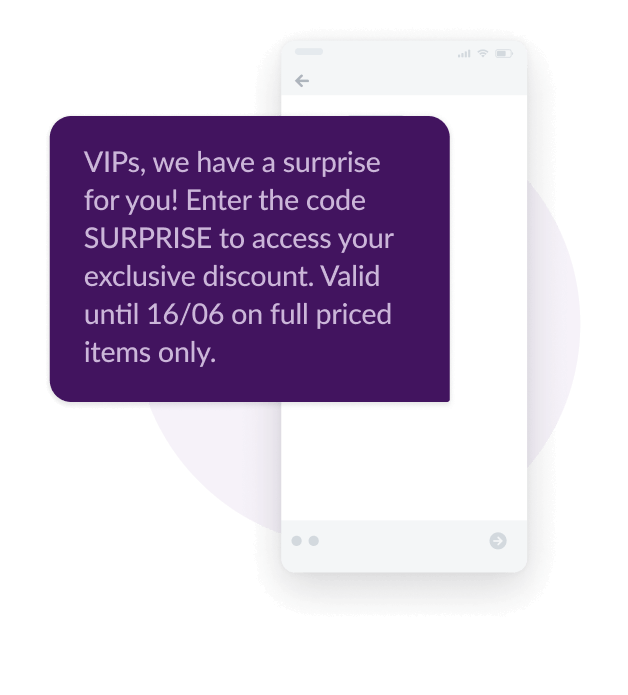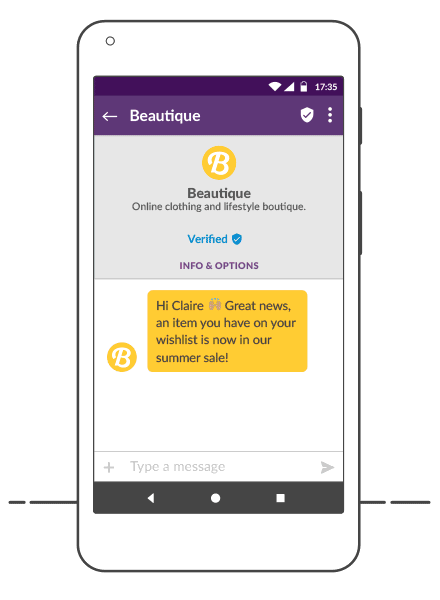
Creating a seamless customer journey from awareness through to purchase means having a joined up approach across all channels. This can be achieved with an omnichannel marketing strategy….
- What is omnichannel marketing?
- What’s the difference between omnichannel and multichannel?
- Why use an omnichannel strategy?
- Pros and cons of an omnichannel strategy
- How to use mobile messaging in an omnichannel strategy
- Omnichannel marketing examples
- How to build a successful omnichannel strategy
- Summary: Why choose an omnichannel approach?
Brands with an omnichannel marketing strategy use a range of channels to connect with customers. That could be through SMS, WhatsApp, email, online, in-store on social media. Ultimately the goal is to create a consistent experience across all channels.
Adopting an omnichannel marketing strategy means that brands can, on average, retain 89% of their customers, which drops to around a third for those without.
Not only that, but 73% of customers actually prefer to use multiple channels when shopping and as our Connected Consumer report found, 94% would open and act on a text message from a business, followed by 92% on email.
Whether you’re new to the topic or just want to learn more, in this guide we explore what omnichannel marketing is, how it works, the pros and cons, and how to create a successful strategy.
What is omnichannel marketing?
Omnichannel marketing is all about connecting with your customers on multiple channels and creating a consistent brand experience across all of them.
The different channels might include:
- SMS
- Website
- App
- Phone call
- Chatbot
- Stores
- Social media
Branding, colours, pictures, layout and design should be consistent across all channels so that the journey to purchase is seamless. Think of the Apple brand: its website, app, stores and packaging are all simple and clean – and instantly recognisable.
Businesses with WhatsApp profiles or rich communications service (RCS) can keep their brand image consistent by using their logo and brand colours when messaging customers.
But omnichannel marketing involves more than just the look and feel of your channels.
It’s also about integrating data to build a better understanding of how your customers interact with different channels, so you can target them more effectively. This drives up conversions and your return on investment (ROI).
This customer-centric approach is driven by personalisation, which 71% of customers now expect. Another 72% want brands to know their interests and treat them as individuals. Omnichannel marketing relies heavily on data from customers’ purchase history, behaviour and preferences to offer personalised recommendations and promotions, customise algorithms and cross-sell.
A good example of this is sending automated and personalised SMS messages to customers when they interact with your brand like basket reminders, in-stock notifications or by promoting matching products. This can redirect their attention back to the product with a link and convince them to complete the purchase.
What’s the difference between omnichannel and multichannel?
The key to understanding the difference between omnichannel and multichannel marketing is in the names. “Multi” suggests “many” or “more than one”, whereas “omni” means “all”.
Both use multiple channels to reach customers, but omnichannel aims to create a seamless experience across all channels.
A multichannel strategy, on the other hand, won’t have this level of cohesion with some channels almost operating in isolation (e.g. store vs website).
Multichannel
A multichannel marketing strategy uses many of the channels available to increase reach, offer customers flexibility and improve engagement. But these channels may not be joined up in their approach, and as a result might operate in silos.
Because they all function on their own, cross-channel sales are difficult and the customer journey is likely to differ across all.
Omnichannel
By connecting all of your channels, customers can move through and across each with ease. By knowing how customers interact with your brand at every stage, you can also target them with personalised offers and recommendations.
Why use an omnichannel strategy?
An omnichannel strategy can lead a satisfied customer further down the marketing funnel to the loyalty and advocacy stages to help you develop lifelong customers. It also encourages repeat sales and recommendations. For example, if a customer shows an interest in your product in-app, a discount code sent through email can prompt them to close the deal and buy.
A consistent brand experience can also improve brand awareness and help customers to remember the positive experience they had with you.
Because the channels are connected, customers can easily pick up where they left off, reducing the chances of a fragmented or frustrating journey. They may have looked at the product in-store, done some investigations after receiving a message in RCS, and then completed the purchase in-app.
The customer data you collect across channels helps to predict behaviour and preferences, offering a complete view into the customer journey. If you only have siloed data from separate channels, it’s difficult to understand how your customer moves across platforms and which ones they prefer.
Pros and cons of an omnichannel strategy
Benefits of an omnichannel strategy
Investing in an omnichannel marketing strategy can deliver a number of benefits including:
- Improved customer loyalty and satisfaction
- Increased revenue
- Targeted personalisation
- Enhanced brand awareness, reputation and memorability
- Securing a competitive edge
- Better data-driven decisions
Cons of an omnichannel strategy
With an omnichannel strategy, brands need reliable infrastructure and technology to manage all channels. And once the foundations are in place it should be smooth sailing. Brands can also improve their return on investment if the strategies used in an omnichannel strategy are cohesive and implemented well.
How to use mobile messaging in an omnichannel strategy
Mobile messaging is one of the fastest ways to reach customers. With almost everyone owning a mobile phone and keeping it close at hand, marketing messages are far more likely to be seen.
It’s also easy to personalise communications and offer convenience helping to improve the CX – key aspects of omnichannel marketing.
SMS
Marketers use SMS to reach a broad audience quickly and directly to communicate offers, send alerts and reminders or in-stock notifications.
In line with an omnichannel strategy, it’s easy to personalise texts with first names or send customised communications like promo codes or event reminders. You can also segment customers into groups or send a personalised bulk message to an entire list.

Another benefit is being able to automate text messages and ensure they’re targeted and transmitted at the right time. For example, if your SMS platform is integrated with your software, you can automatically send a confirmation text as soon as a refund has been processed.
Recommended reading: SMS marketing: How to unlock the power of SMS
RCS
Rich communication service (RCS) messaging is similar to SMS, except you can send rich media such as QR codes, location tags, multimedia including pictures and videos, documents or guides and call to action buttons.

RCS is a great choice if you want to create an interactive experience for customers to help with relationship building, boosting conversions and sales.
It’s a perfect channel for your omnichannel strategy, because it helps to enhance conversations leading to greater satisfaction. Brands can also create a business profile by adding their colours, logo or tagline to ensure a consistent brand experience.
Learn more: SMS vs RCS: Which one should your business choose?
WhatsApp for Business is another great channel to have in your omnichannel assets.
It’s reassuringly familiar, so customers are highly likely to engage with it. Similar to text, you can send documents, pictures, videos, your location and voice notes. It also has read receipts, so you know when a message is read.

WhatsApp is convenient for solving customer queries because it’s a two-way communication channel. Customers can reply at a time that suits them, and you can send information or links to improve their experience. You can also customise it with your brand colours, logo or picture to create consistency.
It’s also a great tool for marketing departments and ecommerce businesses. With features like statuses and broadcast lists, you can reach a wide number of customers to share your latest products or promotions. This can be followed up with a WhatsApp message including a link or button to your sales pages.
Omnichannel marketing examples
Omnichannel marketing is used in a range of sectors like retail, financial, healthcare or travel to improve the user experience and streamline operations. As always, there are some brands leading the way:
Apple
Apple customers can shop using a website and in-store, and both services are well integrated. Customer information is added to their online account, which staff in-store can view to help solve queries.
Customers can also use the website to book in-store appointments and repairs, or connect with a specialist online for further support.
The brand also sends delivery and pick-up updates through SMS so customers know when their order is ready to collect or due for delivery.
Nike
Nike uses their website, stores and apps to reach their customers. Their membership programme involves customers signing up to a personalised app, where they receive customised offers, product recommendations, new products and exclusive deals.
The app also offers a click and collect service where customers pay online and pick-up from a nearby store, and a reserve service for members where they can receive a product online or try it on in-store before making a purchase decision.
Nike also has a SNKRS app which gives customers access to new sneaker launches or events. Customers signing up need to verify their identity using a code sent through SMS.
New Look
Lots of retailers use omnichannel strategies, and New Look is one fashion retailer that is maximising its potential. Through their website, stores and app, customers can shop seamlessly. They offers click and collect, in-store ordering and shoppers can buy products via their social media channels.
Returns can be sent via a delivery service or through the store with a QR code. In-store customers can opt for an email receipt, and items saved in-app baskets are automatically added to the website too and vice versa.
The app and website has a ‘recommended for you’ section based on customers history, interactions and preferences. And when customers need to chat or have a query, they can connect on WhatsApp using the New Look Help business account. The initial query is sent and the business responds with messages like ‘Have you already placed your order?” and then automated buttons like “Yes” or “No.” The customer clicks the relevant button receiving prompt responses and then they might be connected to an advisor.
Explore WhatsApp solutions for your business
Dior
Beauty brands including Dior are using omnichannel strategies to create tailored and memorable experiences both online and in-store.
When a customer buys a product in-store, it is added to their account and if they’re a member, they can opt to receive magazines, personalised emails, samples and birthday gifts. The gifts, like a complimentary makeover at the local beauty counter, are also used to encourage footfall within stores.
Customer data including phone numbers is also collected via an iPad in store to receive communications. Beauty consultants can contact customers through SMS to let them know about in-store events or when they have appointment availability.
The beauty brand also offers a scheme where customers are encouraged to make specific purchases to unlock exclusive advantages and rewards. Dior also offers virtual try-ons on the website for those who can’t make it into the store, and their app lets members know about new products and promotions.
Argos
Argos is another retailer with a website, app and stores that all integrate seamlessly.
Customers can check on the website if stock is available in stores before they head down or can avail of an ‘order now and collect right away’ in nearby shops. In-store there are digital screens where customers can search for products and make payments.
Owned by Sainsburys, members can use the Nectar card – a loyalty scheme where every purchase is rewarded with points and then converted into vouchers. Within the Nectar app, digitally-registered customers can get personalised discounts to use in-store and online based on their buying habits.
Customers can also use a feedback form, chatbot, Facebook Messenger, Twitter, phone call, post or SignVideo to get in touch.
How to build a successful omnichannel strategy
Collect accurate data
Focus on collecting reliable and accurate data about your customers’ purchase history, preferences, attitudes and behaviour. Find out where they prefer to shop, communicate and receive information about new products or offers. Do they like learning about products on social media or by email, and what products do they tend to buy?
For example, our own research found that 80% of customers would act and read a message sent by a business through WhatsApp. On the other hand, customer service advisors can also collect data like mobile numbers in store to sign customers up to communications.
There’s lots of data collection methods – one of the most common is Google Analytics which looks into website performance. But there’s also independent analytical tools for your website or app to track behaviour and purchase history. There are a range of helpful analytical tools for social media, while SMS surveys provide first-hand insights direct from your customer.
Get key insights
Once you have collected the data, it’s time to analyse it. Use analytical tools to identify any trends and patterns. Your customers can then be segmented into groups based on this data, so you can create personalised offers and communications.
Customer journey mapping
Once you have segmented your audience, you can create customer journey maps to help track your customers path across your channels. This way you can identify any issues or preferences to improve their user experience (CX).
Within this, create customer personas and explore their interactions to find out what led them to making a purchase. For example, they may view the product in store and then complete the purchase after receiving an email or text. It’s important to understand their behaviour during this journey and whether they faced any friction or barriers to purchase.
Personalise your messaging
Once you have these profiles, personalised messaging helps you to target customers based on what they actually want. You can group customers together based on their favourite products, where they like to shop or if they’re a frequent buyer. Use their first names in messages, offer solutions, cross-sell and communicate using their preferred channel.
Recommended reading: How to personalise your SMS marketing
Testing
It’s always a good idea to test and refine your omnichannel marketing.
Measure the performance of your SMS, emails or campaigns to find any areas of improvement. Where did customers engage or drop-off, and what are your conversion rates and cost per lead?
Summary: Why choose an omnichannel approach?
With an omnichannel marketing approach, you can reach customers on a number of channels while catering to their needs and preferences. This helps improve the CX, and in turn can lead to lifelong customers who advocate for your brand. Increased revenue, brand awareness and a solid reputation will help you to grow your brand too.
Find out how Esendex can support your omnichannel marketing.



